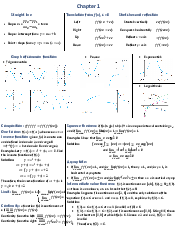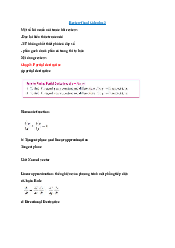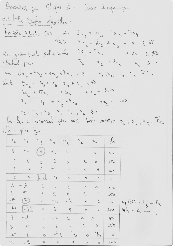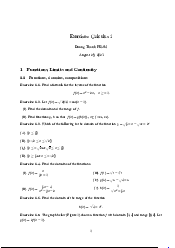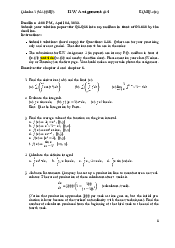




Preview text:
THE INTERNATIONAL UNIVERSITY(IU) - VIETNAM NATIONAL UNIVERSITY - HCMC MIDTERM EXAMINATION
Fall 2013 • Duration: 90 minutes SUBJECT: CALCULUS I
Department of Mathematics Lecturers: Chair:
T.T. Duong , N.N. Hai, J.C. Harris, Assoc. Prof. Dr P.H.A. Ngoc and N.M. Quan Instructions:
• Each student is allowed a scientific calculator and a maximum of two
double-sided sheets of reference material (size A4 or similar), stapled together
and marked with their name and ID. All other documents and electronic de- vices are forbidden.
• Answer any FIVE of the six questions. DO NOT answer more than five questions.
1. A rare species of monkey is introduced to a nature reserve. The popula-
tion p of these monkeys after t years can be modelled by the equation 120 p(t) = , ∀t ≥ 0 1 + 4e−0.5t (a) [7 marks] Find p0(t).
(b) [8 marks] When will the population growth rate be less than 1 monkey per year?
(c) [5 marks] Show that the population will never exceed a certain number. 2. Consider the function − 1 if x < 0 x f (x) = 1 − x if 0 ≤ x ≤ 1 √ x − 1 if x > 1
(a) [5 marks] Find the limits lim f (x) and lim f (x). x→0− x→0+
(b) [5 marks] Is f (x) continuous at x = 0? at x = 1? Explain your answers.
(c) [5 marks] Find all the vertical and horizontal asymptotes.
(d) [5 marks] Sketch the graph of f (x).
----- continued on next page ----- 3. Let f (x) = x2 − x + 3
(a) [5 marks] Find the slope m of the line 3x + 2y = 7.
(b) [5 marks] Find x ∈ R such that f0(x) = m.
(c) [5 marks] Find an equation of the straight line that is a tangent to the
graph of f and parallel to the line 3x + 2y = 7.
(d) [5 marks] Find the straight lines that are tangents to the graph of f and
pass through the point ( 3, 11 ). 4 4 √ 4.
(a) [6 marks] Find f 0(π ) where f(x) = 1 + 2 tan x. 4
(b) [7 marks] Show that lim xecos2(π ) x = 0. x→0
(c) [7 marks] A differentiable function y(x) is defined near x = 0 and is such that x3 + y3 = 1 + 5xy2 Find y(0) and y0(0).
5. An object is thrown upward and then falls to the ground. The object’s
height h (in feet) above ground level is given by the function h(t) = −16t2 + bt + c
where t is the time (in seconds) after the object is released. The object
is released at an initial height of 6 feet and it lands on the ground after 6 seconds.
(a) [10 marks] Find the initial speed of the object.
(b) [10 marks] Find the maximum height reached by the object.
6. Let f (x) = 5e3x − 3e−2x, then f is a one-to-one function from R onto R.
Let g be the inverse function of f , and evaluate the following:
(a) [5 marks] f (0), f 0(0), f 00(0). (b) [10 marks] g0(2). (c) [5 marks] g00(2). ----- END ----- ANSWERS
Instructions: In the case that the student answered all 6 questions,
grade questions 1 through 5. For any part that is worth 5 marks, if there is
anything wrong in the final answer, at most 4 marks will be given. 1. 120 p(t) = 1 + 4e−0.5t (a) [7 marks] 240e−0.5t p0(t) = (1 + 4e−0.5t)2
(b) [8 marks] Solve the inequality 240e−0.5t p0(t) = < 1 (1 + 4e−0.5t)2
which is equivalent to 16X2 − 232X + 1 > 0 where X = e−0.5t.
Since t > 0, we choose the solution t > 10.89.
(c) [5 marks] Since e−0.5t > 0, 1 + 4e−0.5t > 1 and therefore p(t) < 120. 2. Consider the function − 1 if x < 0 x f (x) = 1 − x if 0 ≤ x ≤ 1 √ x − 1 if x > 1
(a) [5 marks] Find the limits lim f (x) and lim f (x). x→0− x→0+ −1 lim f (x) = lim
= ∞ and lim f(x) = lim (1 − x) = 1. x→0− x→0− x x→0+ x→0+
(b) [5 marks] Is f (x) continuous at x = 0? at x = 1? Explain your answers.
f is not continuous at 0 because lim f (x) 6= lim f(x) and f is continuous x→0− x→0+ √
at 1 because lim f (x) = lim (1 − x) = 0 = lim f(x) = lim x − 1 x→1− x→1− x→1+ x→1+
(c) [5 marks] Find all the vertical and horizontal asymptotes.
The horizontal asymptote is the x-axis y = 0 and the vertical asymptote is the y-axis x = 0.
(d) [5 marks] Sketch the graph of f (x). 3. Let f (x) = x2 − x + 3
(a) [5 marks] Find the slope m of the line 3x + 2y = 7. y = −3x + 7 , hence m = −3 2 2 2
(b) [5 marks] Find x ∈ R such that f0(x) = m.
Solve the equation f 0(x) = 2x − 1 = −3 which implies x = −1 2 4
(c) [5 marks] Find an equation of the straight line that is tangent to the
graph of f and parallel to the line 3x + 2y = 7.
It is the tangent line at x = −1 and y = f(−1) = 53 and an equation is 4 4 16
y − 53 = −3(x + 1) or y = −3 x + 47 16 2 4 2 16
(d) [5 marks] Find the straight lines that are tangent to the graph of f
and going through the point ( 3 , 11 ) 4 4 Find x such that y − 11 f 0(x) = 2x − 1 = 4 x − 34
Therefore (2x − 1)(x − 3) = (x2 − x + 3) − 11 or x2 − 3x + 1 = 0. 4 4 2 2
For x = 1, the slope m = 2x − 1 = 0 and the tangent line is y = 11 2 4
For x = 1, the slope m = 2x − 1 = 1 and the tangent line is y = x + 2. 4. Evaluate the following: √
(a) [6 marks] f 0(π ) where f (x) = 1 + 2 tan x 4 1 π 2 f 0(x) = √ , f 0( ) = √ cos2 x 1 + 2 tan x 4 3
(b) [7 marks] Since −e|x| ≤ xecos2(π) x
≤ e|x|, we can apply the Sandwich theorem and get lim xecos2(π ) x = lim e|x| = 0 x→0 x→0
(c) [7 marks] For x = 0, the equation is y = 1, therefore y(0) = 1.
Differentiate the equation at x = 0, we have
3(0)2 + 3y(0)2y0(0) = 5(y(0))2 + 5(0)2y(0)y0(0) or y0(0) = 5. 3 5. h(t) = −16t2 + bt + c.
(a) [10 marks] Find the initial speed of the object.
c = h(0) = 6, h(6) = −16(36) + 6b + 6 = 0 which implies b = 95. Therefore
the initial speed is h0(0) = b = 95(ft/sec)
(b) [10 marks] Find the maximum height of the object.
The maximum height is at the vertex of the parabola where t = − b = 95. 2(−16) 32
Hence, the maximum height is h(95) = 952 + 6 ≈ 147(ft) 32 64
6. Let f (x) = 5e3x − 3e−2x, then f is an increasing bijection from R onto
R. Let g be the inverse function of f , and evaluate the following:
(a) [5 marks] f (0), f 0(0), f 00(0).
f (0) = 5 − 3 = 2, f0(0) = 15 + 6 = 21, f00(0) = 45 − 12 = 33 (b) [10 marks] g0(2). g0(2) = g0(f (0)) = 1 = 1 f 0(0) 21 (c) [5 marks] g00(2).
Let F (x) = g0(f (x)) = 1 , then F 0(0) = g00(f (0))f 0(0) = −f00(0) . f 0(x) (f 0(0))2
Hence g00(2) = g00(f (0)) = − 33 = − 11 . 213 3087
